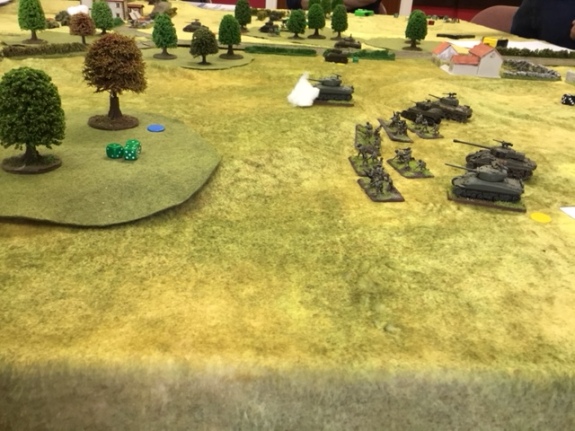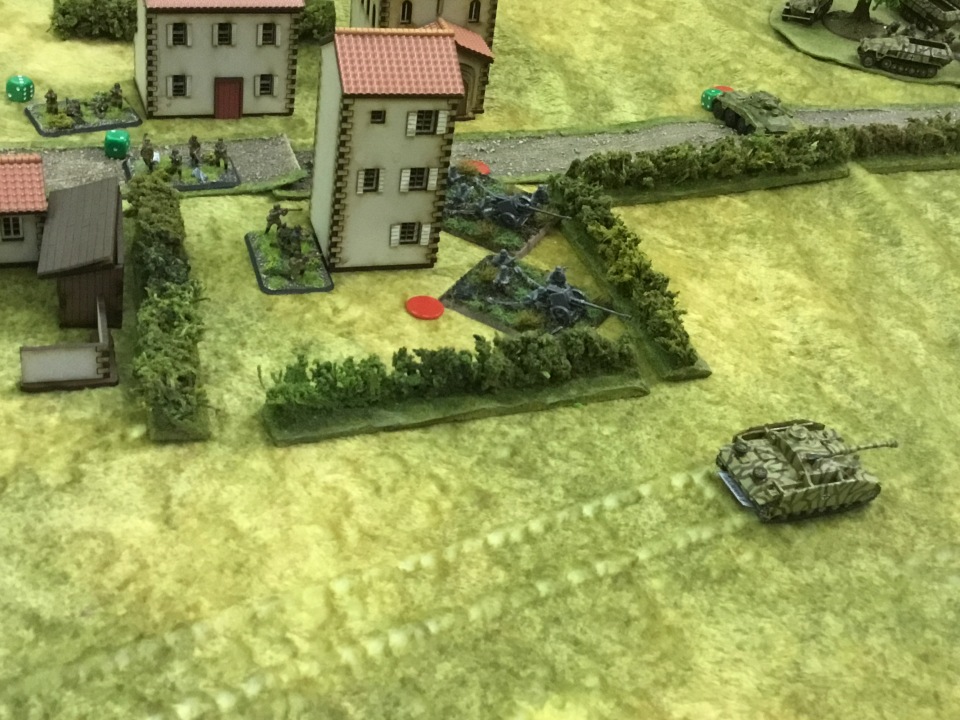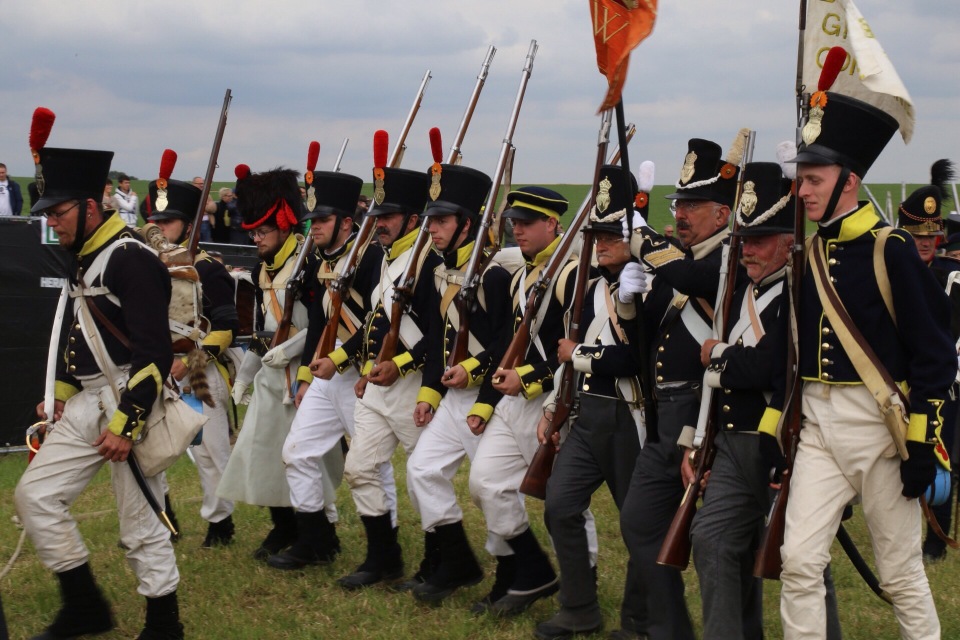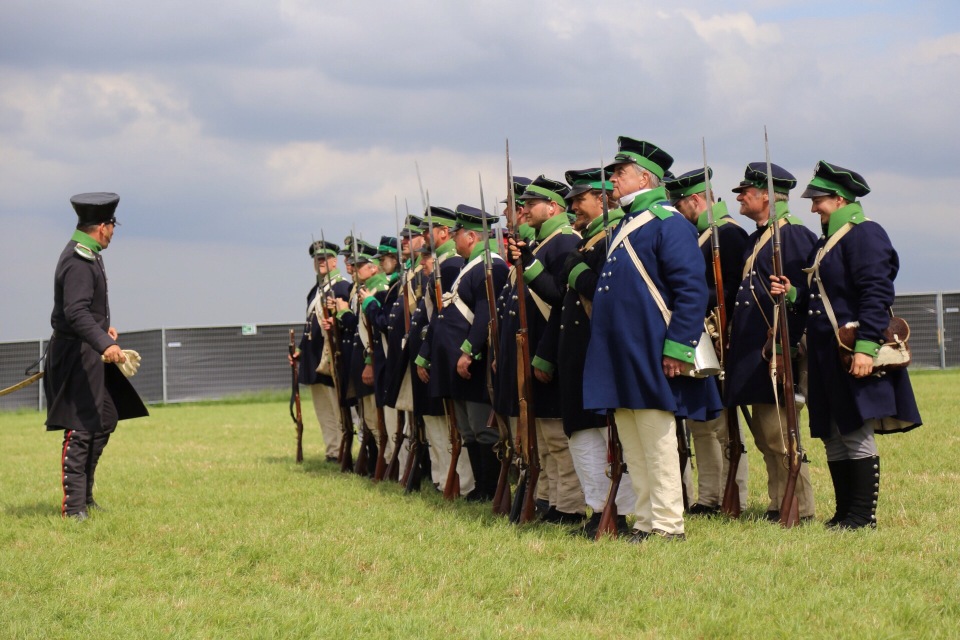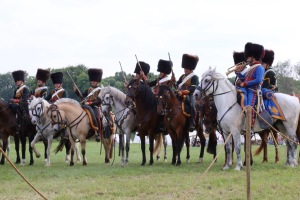On the 17th of October 9 players and a number of entheuastic spectators met to play out a Napoleonic encounter between French and British. The idea for the game first came to light a year ago. At that time we had no 28mm napoleonic figures at all. So began a year long buying and painting program which would eventually lead to the recent battle. 1200 figures, with troops closely based on the Quatre Bras OOB, found their way to the table in the end.
Waterloo had ended and Napoleon had left the battlefield and gone back to paris in a huff. But Ney managed to rally some of the retreating French troops and had high hopes of still winning the campaign and pushing the British and Allied troops back.
To make things a bit more realistic we used one of the Scharnhorst maps from the excellent Blucher ruleset which most of us have and had been playing recently.

Flanders Map Movement
The campaign started with the French and Allied forces manoeuvring for position. The first night the French sent out a strong cavalry force to see if they could find and identify the enemy location and route of march. The light allied screen was easily driven off and this early victory and gathering of intelligence was to prove vital as the forces concetrated for battle the next morning. The French (blue arrows) had concentrated their forces and moved east in an attempt to cross the river at Oudenese. The allies had split their forces choosing to have two columns stay north and capture the strategic town of Deinzel. With the French now in possession of Oudenese and Duifel and forming behind the river, both sides realised that a large part of the allied force was still moving just south of Deinzil and it would be late in the day before they would have any affect in the imminent battle. The green border shows the final position on the map and the table upon which we would play.
The Battle
So it was that that morning the Allied troops were outnumbered 3 to 2. Their orders to hold the initial French attack long enough for the reinforcements to arrive. On the left flank and well in advance of the rest of the army a lone British brigade had deployed on top of a ridge line covering the river crossing.

British advance to deploy on hill while the French arrive on the far side of the river
A few companies of rifles held a small wood at the foot of the hills much closer to the river. The Brunswick brigade held the centre of the allied position in support.
On the allied right the 2nd Netherlands division and the 3rd Infantry Division advanced towards the town of Dracula and prepared to attack it. Dracula was to suck in troops all day long and exchange hands many times with much spilt blood throughout the day.

British Gurad units press home the attack on Dracula

British Brigade begins the attack.
It wasn’t long before the drums of the familiar “Pas de Charge” could be heard. The French had spotted the isolated British brigade on the hill by the river and this was to be their first target. Two large infantry brigades supported by what seemed like a somewhat reluctant brigade of Dragoons attacked in columns.

French columns and Pas de Charge in unison
Light guns from another French light cavalry brigade supported the attack from a hill opposite. The British were hopelessly outnumbered. The rifles did their best to disrupt the French formations but they just kept coming. The British lines at first held steady as column after column climbed the hill towards them. The allied troops at Dracula tried to advance to threaten the flank of one of the French brigades but in the end the French were victorious and the British forward troops melted away and took no further part in the battle.
The first act of the battle it seemed was over. The victorious French brigades took some time to reform as a fresh French division arrived and marched towards Dracula.

British ordered to attack French Dragoons on left flank
For a time a large gap had appeared to the left of the Brunswicker’s but the arrival of allied dragoons and light cavalry brigade plugged the gap almost immediately. For some time the brave Brunswickers Hussars repeatedly charged the French columns forcing them into square and slowing their advance.
Close by the British and French Dragoons stood facing each other wondering if this day they would be victors or vanquished.
A French brigade was in possession of Dracula and another, that had been part of the same division which attacked the British hill, turned ninety degrees and was now involved in the battle at the same location.
Despite facing the Dutch, British and Brunswick brigades they held on, for a while at least, before the 73rd Highlanders managed to force them out of the town. For the next couple of hours this was the main focus of the French attack.

French Cavalry arrive to support the attack on the town
Both sides fought heroically although Wellington did at one point, take it upon himself to ride over to the Brunswickers and exchange harsh words with the Duke about his unwillingness to leave the hill.
In the distance two fresh French brigades had arrived and pressed home their attack on Dracula once more to evict the highlanders and reclaim the prize.

French Dragoons and Lancers watch closely ready to pick up the pieces
At the same time a brigade of French dragoons arrived and quickly took up position in the centre of the French line.

These units gradually forced back the Brunswick infantry to their starting position and the relative safety of the hill south of Dracula.
The Brunswick Hussars and now an allied light cavalry brigade were causing havoc with the French columns on the allied left. The French dragoons in support had no option but to charge the allied dragoons.
Things didn’t go well for the allies and within 15 minutes two regiments had been badly beaten and had to withdraw. This gave the dragoons the freedom to attack the allied light cavalry and allowed the infantry to renew their advance once more.

As the forces around Dracula ground each other to a halt, the unthinkable happened. West of the town , clearly visible, Wellington spotted the head of three French battalions of the French Guard. This is what the allies had feared. Even though to the rear of the front line a fresh British infantry division had arrived was marching to shore up any gaps and replace the by now unsteady brigades, it looked like this would be the final blow. The Guard advanced towards the town and first settled on attacking a battalion of Nassau.

The Guard are coming!
These troops had fought most of the day but had stood firm. As the French attacked and awaited what would be their inevitable victory, the Nassau responded with a thunderous volley and charge. Troops stood back in amazement as the guard faltered and withdrew. Shouts of “la Guarde Recule” and “merde” could clearly be heard as the allied troops watching nearby raised their Shakos on the end of their bayonets in salute.
A historic moment had been achieved but it was never going to be a winning one. The Guard were relentless. They took the town and set about forming up to press home their advantage.
The fresh British troops were arriving close by but night had fallen.

Picton finally arrives but too late to effect the battle
It was much too dark to risk the remainder of his troops wandering into the guard unprepared, and so Wellington admitted defeat and withdrew.

